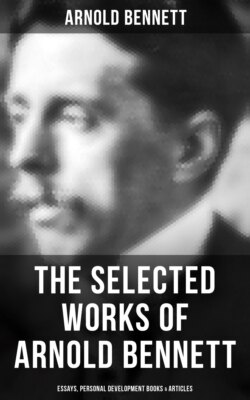Читать книгу The Selected Works of Arnold Bennett: Essays, Personal Development Books & Articles - Arnold Bennett - Страница 58
На сайте Литреса книга снята с продажи.
Process of Invention.
ОглавлениеThe minimum length of the short story of commerce is about one thousand five hundred words, and the tyro will do well to try that length. I will attend him in detail through his maiden enterprise. A work of fiction should properly take shape in the mind of the author in the following stages: —First, he should get a notion of the scene and general environment; then, the characters should present themselves, springing out of the environment; last of all, the plot should present itself, springing out of the characters. This natural order applies both to novels and to short stories; but it perhaps applies more particularly to novels; and in short stories the actual practice is often a reversal of the order. The central idea of the plot comes first, then the characters, then the environment.
The plot of a fifteen-hundred-word story cannot be much more than a mere episode. But, however slight a plot is, it must have a central idea; it must have a “point”; it must raise an issue and settle that issue; the interest of the reader having been excited must be fully satisfied. In other words, the plot must be complete; it cannot be a mere slice cut from something longer. In inventing his plot, the tyro should err on the side of melodrama and ingenuity, rather than on the side of quietude and simplicity. What he wants is a tale that “tells itself,” a striking situation, a novel climax. Too much plot is better than not enough plot. I can offer no suggestions as to subject; the story may or may not relate to love; but it must not end unhappily—this is essential.
Having arrived at a fairly precise notion of his story, the tyro should write down the naked plot in two or three hundred words, or he should explain it to a friend. If the plot will not stand this test, it is not a good plot for his purposes. If it will, he may proceed, for a tale that looks interesting in outline will bear telling in full. When he has briefly sketched his plot in writing, and is convinced that it works up to a good climax and is complete in itself, he will decide definitely on the environment and on the minor details. The story ought now to lie before his mind’s eye like a map. Small as it is, it will divide itself naturally into several parts. He must not begin the story with a piece of explanation. Begin always with action, so that the reader’s interest may be aroused at once; necessary explanations and descriptions must come later.
Here let me insist on an extremely inportant rule of composition that specially applies to the very short story. Every part of a work of fiction should serve more than one purpose. If it is necessary, for instance, that a character should be described, the writer must not be content with describing it; he must devise such incidents as will illustrate the character in action. Assuming that for the proper effectiveness of his climax certain preliminary incidents are required, and also certain preliminary expositions of character, the writer might of course invent incidents which merely prepared the reader for the climax, and he might separately analyse and set forth the character; ultimately he would arrive at his climax. But how much neater, cleaner, more economical, and more effective, if he takes the trouble to invent incidents which serve the double purpose of leading up to the climax and of illustrating the character! The short - story writer, like the juggler who simultaneously spins a plate in one hand, tosses three balls in the other, and balances a stick on his nose, must know how to do several things at once.
